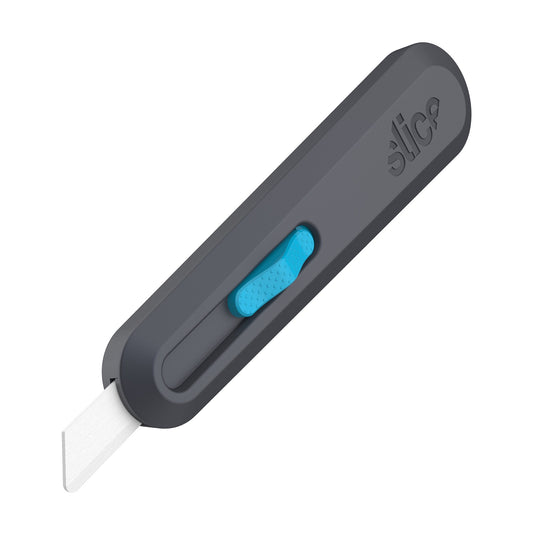A Safety Utility Knife: Demand Safety From Every Angle

Occupation Health and Safety (OHS) professionals are always looking for new ways to reduce common workplace injuries like lacerations. Replacing a dangerous utility knife by mandating the use of a safety utility knife is an excellent start. No matter how much effort goes into utility knife safety training, razor-sharp metal blades dull quickly, rust easily, and pose a threat to workers, and traditional ceramic blades are dangerously sharp, too—sometimes even sharper than metal blades. Although many manufacturers attempt to improve the design of safety knives for work, most safety cutting tools only mitigate a small portion of the possible risks posed by hand-held knives.
Handle Styles for Safety Knives
The easiest, and by far most common, way to improve the safety of utility knives is to redesign the handle. Usually, changes in the handle are aimed at reducing blade exposure, particularly when the knife is not active. There are two ways to do this: recessing the blade (as in a hooked blade) so the user can’t touch the edge accidentally, and creating some form of retractable safety knife. Micro-ceramic blades are a third safety option, but their cuts are too shallow to truly replace a utility-style knife.
Until recently, the only option for safer blade retraction was an auto-retracting utility knife. This style requires the user to engage a slider to keep the blade exposed. When the user releases the slider, the blade retracts automatically. This prevents the user from accidentally leaving the blade exposed when the tool’s not in use. And if the user drops the tool, the blade will retract and not become a flying hazard.
Smart Retract: A Class of its Own
The newer style of self-retracting utility knife takes safety one step further, preventing accidental injuries if the knife slips during the act of cutting. In these tools, the blade pulls back into the housing as soon as it loses contact with the cutting material—even when the user’s thumb is still on the slider. The Slice® 10558 Smart-Retracting Utility Knife is our safest knife yet and, we believe, the safest knife on the market. In the following video, our founder TJ Scimone demonstrates the Smart Retract feature.
Many safety managers require that workers use auto-retractable handles for safety reasons. A standard worker complaint is that, over the course of a long shift, the strain of pushing and releasing the slider to engage the blade causes fatigue or even repetitive strain injury. The Slice 10558 Smart-Retracting Utility Knife offers a solution: Ergo Pull™ technology.
Slice developed Ergo Pull to improve the long-term health of workers using the Smart-Retracting Utility Knife. Instead of pushing a slider to expose the blade, the user pulls it to keep the blade exposed. This means the force on the slider is going in the same direction as the force of the cut. And the position of the slider, when engaged, results in a solid, balanced grip with less rotational wrist strain. Traditional designs require the user to rotate their hand awkwardly.
Third-party independent testing proves that the Ergo Pull slider reduces muscular effort in the hand, forearm, and upper arm muscles.* Slice’s better design reduces the chance of long-term injuries due to strain and fatigue, therefore lowering company costs and improving worker well-being.
Why a Ceramic Safety Knife? Why Slice?
New handle designs do a good job of reducing blade exposure and repetitive strain, but that only partially mitigates the risks of utility knives. After all, what cuts you: the handle or the blade?

As you can see, only about 20 percent of the risks caused by utility knives are adequately addressed with better handles. Metal blades are overly sharp, and manufacturers of traditional ceramic blades mimic this dangerously sharp design: many traditional ceramic blades are even sharper than metal blades. In the end, if your skin comes in contact with a dangerously sharp metal or ceramic blade, you’re likely to get injured. That’s why Slice believes strongly in the power of better blade design.
When we designed our safety utility knives, we didn’t stop at the handle: we included unique utility knife blades and box cutter blades featuring our patent-pending finger-friendly® edge grind. They’re much safer than metal and other ceramic blades. In fact, Slice utility blades are safe enough to touch.
The utility knife is one of the most common hand tools in any workplace and therefore a natural starting point for safety improvements. But before you choose a safety utility knife, make sure you understand safety cutting from every angle, and especially from the cutting edge.
* Independently tested in September 2016 by United States Ergonomics, Sea Cliff, NY
More Information
- Video: Why Slice Blades Are Safer Than Traditional Blades
- Article: The Safety Knife: How to Find the Safest
- FAQ: Are All Ceramic Blades Safer?
-
Cutter retráctil inteligente
Precio habitual $31.99 USDPrecio habitualPrecio unitario por

